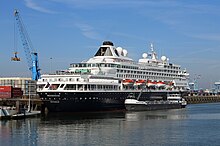Bunkering





Bunkeringis the supplying offuelfor use byships(such fuelis referred to asbunker),[1]including the logistics of loading and distributing the fuel among available shipboard tanks.[2]A person dealing in trade of bunker (fuel) is called a bunker trader.
The term bunkering originated in the days ofsteamships,whencoalwas stored in bunkers.[1]Nowadays, the term bunker is generally applied to thepetroleumproducts stored intanks,and bunkering to the practice and business of refueling ships. Bunkering operations take place atseaportsand include the storage and provision of the bunker (ship fuels) to vessels.[3]
ThePort of Singaporeis currently the largest bunkering port in the world.[4]In 2023, Singapore recorded bunker fuel[5]sales volume totaling 51,824,000 tonnes, setting a new industry standard.
TheIsland of Maltais known to host bunkering, in six locations includingHurd's bank.In 2015 theMalta-Sicily Channelwas noted as "one of the most important oil transit routes in the world," and in 2011, around eight vessels per day bunkered in Maltese waters.[6]
Two types of Bunkering
[edit]The two most common types of bunkering procedure at sea isShip to Ship Bunkering(STSB) in which one ship acts as a terminal whilst the other moors. The second type isStern Line Bunkering(SLB), which is the easiest method of transferring oil, but can be risky during bad weather.[7]
Bunkering in maritime law
[edit]In many maritime contracts, such ascharter parties,contracts for carriage of goods by sea,[8]andmarine insurance policies,[9]theship-ownerorship operatoris required to ensure that the ship isseaworthy.Seaworthiness requires not only that the ship be sound and properly crewed, but also that it be fully fuelled (or "bunkered" ) at the start of the voyage.[10]If the ship operator wishes to bunker en route, this must be provided for in a written agreement, or the interruption of the voyage may be deemed to bedeviation(a seriousbreach of contract). If the vessel runs out of fuel in mid-ocean, this also constitutes serious breach, allowing the insurer to cancel a policy[11][12]and allowing aconsigneeto make a cargo claim. It may also lead to asalvageoperation.
TheInternational Maritime Organisationis an agency of theUnited Nationsresponsible for the prevention ofmarine pollutionby ships. On 1 January 2020, the agency began enforcing the IMO 2020 regulation ofMARPOLAnnex VIto minimise bunkering's environmental impact.[13]
References
[edit]- ^abManaadiar, Hariesh (August 2011)."What is Bunker and Bunkering".Shipping and Freight Resource.Puthan House.Retrieved27 June2016.
- ^MOHIT (19 October 2010)."Bunkering is Dangerous: Procedure for Bunkering Operation on a Ship".Marine Insight.Retrieved16 January2015Site seems to require enabling ofcookies.
{{cite web}}:CS1 maint: postscript (link) - ^"Bunkering".Maritime and Port Authority of Singapore (MPA). Archived fromthe originalon 7 January 2015.Retrieved16 January2015.
- ^"Page 143 - WOO 2014".opec.org.Retrieved2020-11-24.
- ^"Port of Singapore Achieves Historic Bunker Sales in 2023".Bunker Market.2024-01-15.Retrieved2024-03-17.
- ^"Exposing underwater devastation".22 March 2015.
- ^"Bunker Fuel Solutions for Marine Vessels | Dan-Bunkering".dan-bunkering.Retrieved2023-06-28.
- ^See the United States'Harter Act
- ^Marine Insurance Act 1906
- ^TheHague–Visby RulesArticles II & III
- ^Greenock Steamship Co v Marine Insurance[1903] 2 K.B. 657
- ^If the policy has a "held-covered" clause, the deviation will not allow immediate cancellation
- ^"Air Pollution".imo.org.RetrievedOctober 14,2020.
